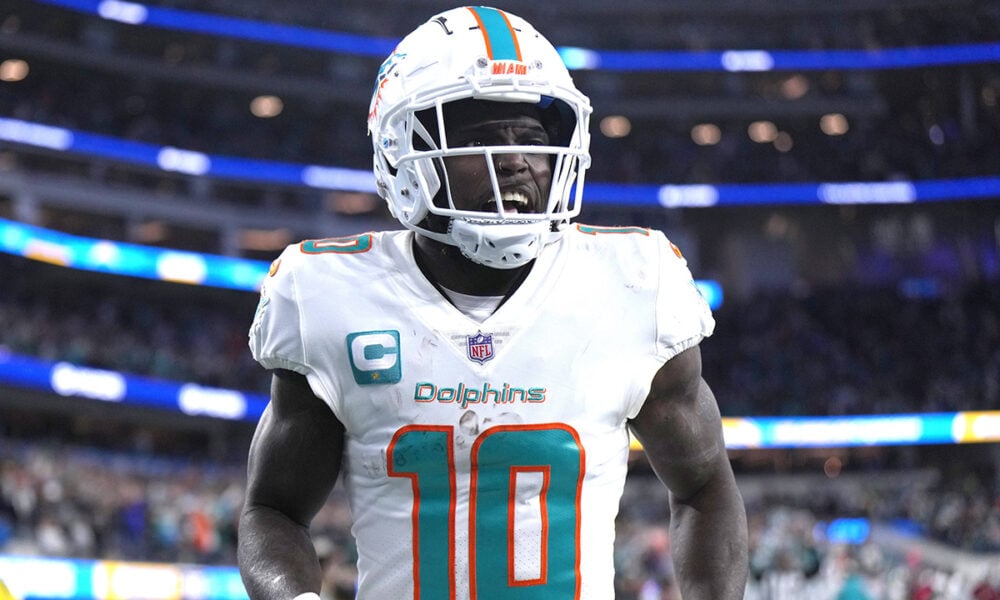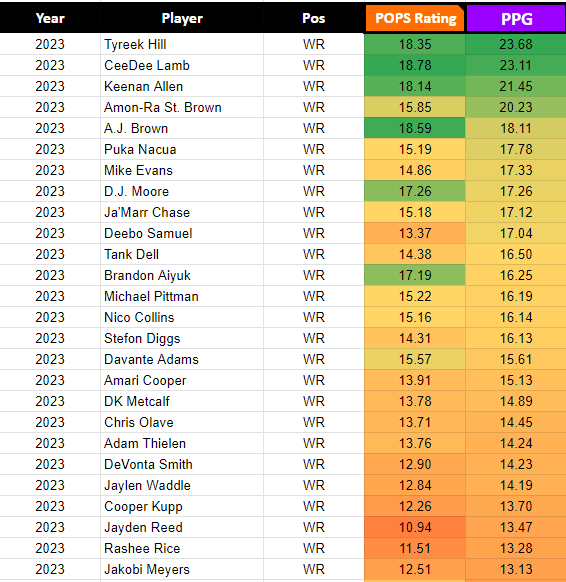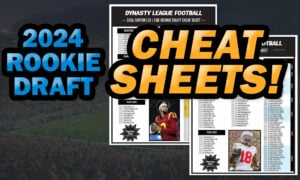Introducing POPs Rating: A Novel Metric for Assessing Wide Receiver Performance

I know what you’re thinking: another fantasy football metric with an acronym, as if we don’t have enough of those. But bear with me—I think I have a good one here, or at least one that doesn’t suck. It’s called POPs Rating.
While the acronym might seem like just another addition to the sea of statistics, its components—Production, Opportunity, and Skill—combine to create a new metric for evaluating WRs in fantasy football. This article delves into the intricacies of POPs Rating, exploring its construction, relevance, and predictive power.
The Basics of POPs Rating
At its core, POPs Rating encapsulates these three essential elements:
Production:
This simply refers to PPR points per game. We understand that past production is one of the most predictive metrics for forecasting future PPG. It serves as the foundational piece of POPs Rating.
Opportunity:
Created by Josh Hermsmeyer, Weighted Opportunity Rating (WOPR) offers a nuanced understanding of a player’s involvement in their team’s passing game. By incorporating Airyard Share and Target Share, WOPR adjusts for both the volume and depth of targets, providing a comprehensive view of a receiver’s role within their offense.
Skill:
Leveraging ESPN’s Receiver Tracking Metrics OVR Score, The “Skill” factor in POPs Rating evaluates a wide receiver’s overall skill level based on route running ability, catching ability, and the ability to gain yards after the catch.
How It’s Calculated
The first step in calculating POPs Rating is converting WOPR and OVR Score to the scale of PPR PPG. These converted metrics will be called WOPR PPG and OVR Score PPG.
Here are the formulas for each:
WOPR PPG = 0.4 + (WOPR * 0.25)
OVR Score PPG = -1.5 + (OVR Score * 0.2)
Now that we have WOPR and OVR Score on the same scale as PPG, here is the final formula for POPs Rating. (It’s just an average)
POPs Rating = (PPG+WOPR PPG+OVR Score PPG)/3
Understanding POPs Rating:
POPs Rating aims to provide a more holistic evaluation of a wide receiver’s performance. This metric is meant to give you a better idea of what players have the ability to be fantasy studs in the future, rather than just telling you who was good in the past.
Assessing Utility and Predictiveness
Now, the question arises: is POPs Rating merely another statistic, or does it possess predictive power? Let’s look at how POPs Rating fares in predicting PPG in the next year.


The scatterplots above show how closely each predictor aligns with actual point production. The number at the top of each plot, called the R-squared value, indicates how well each predictor explains or predicts future points. It ranges from 0 to 1, where higher values mean better predictions.
Both POPs Rating and PPR PPG predict future points similarly, as shown by their comparable R-squared values. Even though POPs Rating appears slightly worse than PPG, it still holds its value. This is because POPs Rating provides us with a different leaderboard than PPG does. Some players rank higher or lower in the POPs Rating ranks than they do in PPG. This provides an opportunity to take a contrarian approach and potentially identify undervalued WRs.
I like to think of the POPs Rating Leaderboard as expert redraft rankings, which can be translated to dynasty by filtering for age. It is a useful tool that goes beyond a player’s past production alone, accounting for the opportunity a player gets as well as the inherent skill they possess. Next, we’ll take a look at the POPs Rating Leaderboard from 2023 to get an idea of what we’re working with.
2023 POPs Rating Leaderboard

As you can see, there are many players who have discrepancies between their PPG and their POPs Rating. While this should not be taken as gospel, it can be used as a tool to come up with trade ideas. Keep in mind that context is important; maybe Cooper Kupp had a down year due to injuries in the 2023 season. Or maybe this is a sign that retirement is around the corner. Simply put, this is just a guide, and it is still very much open to interpretation.
Closing Thoughts:
The goal here is for POPs Rating to allow you to think a bit differently than your league mates without sacrificing predictiveness. Keeping the metric simple and intuitive was paramount. Whenever you create a model of any sort, you run the risk of overfitting, so keeping it simple helps avoid that. If you’d like to take a look at all the POPs Rating data, you can access the POPs Rating Database. Feel free to reach out to me @cplant_on 𝕏 with any questions, comments, or concerns you may have.
- Introducing POPs Rating: A Novel Metric for Assessing Wide Receiver Performance - April 8, 2024
- Connor LaPlante: Dynasty Fantasy Football Rankings Explained - February 10, 2023


































































